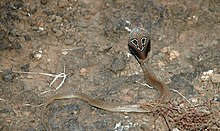Spectacled snake
| Spectacled snake | ||||||||||||
|---|---|---|---|---|---|---|---|---|---|---|---|---|

Glasses snake ( well well ) |
||||||||||||
| Systematics | ||||||||||||
|
||||||||||||
| Scientific name | ||||||||||||
| Well well | ||||||||||||
| ( Linnaeus , 1758) |
The cobra ( Naja naja ), also Spectacled Cobra or short Cobra is a 1.2 to 1.7 meter long poisonous snake (Elapidae) and one of the most endangered species of the genus of genuine cobras ( Naja ). It is active both during the day and at dusk and feeds on mammals, amphibians, reptiles, birds and their eggs. Spectacled snakes are dangerous venomous snakes that cause serious accidents relatively often. Farmers are particularly often bitten in their rice fields, where the animals hunt rats and other small mammals.
Features and appearance
The spectacle snake can be drawn quite differently, but most of the specimens have the typical marking on the back of the pronotum, reminiscent of glasses. The coloring of the animals is mostly monochrome brown. Other specimens, especially those from Nepal , are pitch black and have indistinct markings.
Distribution and occurrence
Spectacled snakes occur from the southern Himalayas to Sri Lanka . There they colonize low mountain range forests as well as lowland forests, rice fields and habitats near human settlements .
Reproduction
The mating season extends over the whole year in most of the distribution areas. If a pair ready to mate has been found, mating takes place, as is typical for snakes, by wrapping around each other. The male penetrates the female's cloaca with his sexual organ . The female lays between ten and twenty, rarely up to thirty eggs. Unlike most snake species, the spectacled snake practices self-sacrificing brood care. The eggs are usually laid in a hollow tree or in similarly protected places. The female watches over the clutch until the young snakes hatch. Depending on the ambient temperature, the young snakes hatch after 50 to 60 days. They are already well developed, have a hatch length of 25 to 30 centimeters and have the characteristic neck shield and fully developed poison glands.
Threat and protection
The spectacled snake is considered a sought-after object by poachers. The Washington Convention on the Protection of Species, Appendix II, places animals under worldwide protection, and trade in animals and products from them is prohibited. Capturing the animals in the wild to keep them as pets is also a criminal offense. Nevertheless, the animals are often caught by snake charmers for their performances.
Special
This snake can be seen at performances by Indian snake charmers ; it is considered sacred by Buddhist monks and Hindus .
See also
literature
- Mark O'Shea, Tim Halliday: Reptiles and Amphibians. Dorling-Kindersley Verlag, London 2001, ISBN 3-8310-1015-3 .

